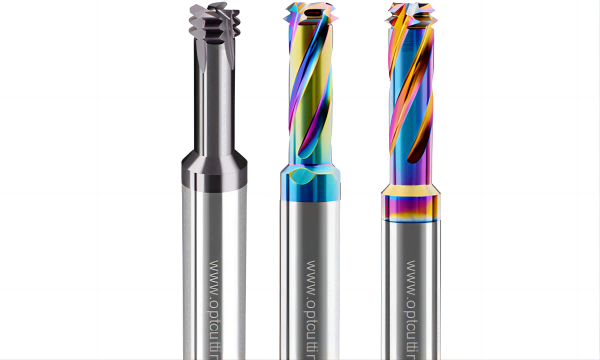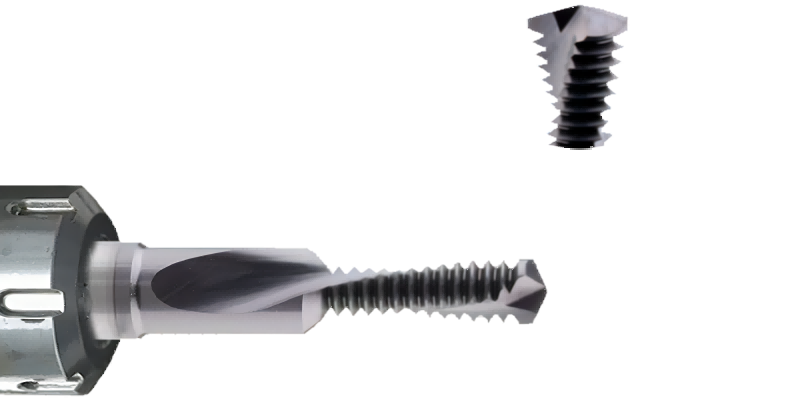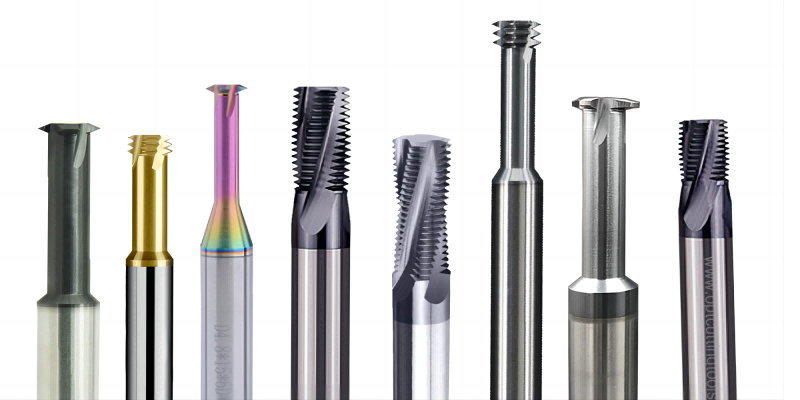With the popularization of CNC machine tools, the application of thread milling technology in the mechanical manufacturing industry is increasing. Thread milling is to form thread by three-axis linkage of CNC machine tool and spiral interpolation milling with thread milling cutter. Each Circular motion movement of the cutter on the horizontal plane will move one pitch in a straight line in the vertical plane. Thread milling has many advantages, such as high processing efficiency, high thread quality, good tool versatility, and good processing safety. There are many types of thread milling cutters currently used. This article analyzes seven common thread milling cutters from the perspectives of application characteristics, tool structure, and processing technology.
Ordinary machine clamp thread milling cutter
Machine clamp type thread milling cutter is the most commonly used and cost-effective tool in thread milling. Its structure is similar to that of a regular machine clamp type milling cutter, consisting of a reusable tool shank and easily replaceable blades. If it is necessary to process conical threads, a special tool holder and blade for processing conical threads can also be used. This blade has multiple thread cutting teeth, and the tool can process multiple thread teeth in one cycle along the spiral line. For example, using a milling cutter with 5 2mm thread cutting teeth and processing along the spiral line in one cycle can process 5 thread teeth with a depth of 10mm. In order to further improve processing efficiency, a multi blade machine clamp type thread milling cutter can be selected. By increasing the number of cutting edges, the feed rate can be significantly improved, but the radial and axial positioning errors between each blade distributed on the circumference can affect the accuracy of thread machining. If the thread accuracy of the multi blade machine clamp thread milling cutter is not met, it can also be attempted to install only one blade for processing. When selecting a machine clamp type thread milling cutter, it is advisable to choose a larger diameter cutter rod and appropriate blade material based on factors such as the diameter, depth, and workpiece material of the processed thread. The thread processing depth of the machine clamp type thread milling cutter is determined by the effective cutting depth of the tool holder. Due to the fact that the length of the blade is less than the effective cutting depth of the tool holder, it is necessary to process in layers when the depth of the processed thread is greater than the length of the blade.
Ordinary integral thread milling cutter
Most integral thread milling cutters are made of integral hard alloy materials, and some even use coatings. The integral thread milling cutter has a compact structure and is more suitable for processing medium to small diameter threads; There are also integrated thread milling cutters used for processing tapered threads. This type of tool has good rigidity, especially the integral thread milling cutter with spiral grooves, which can effectively reduce cutting load and improve processing efficiency when processing high hardness materials. The cutting edge of the integrated thread milling cutter is covered with thread processing teeth, and the entire thread processing can be completed by machining along the spiral line in one cycle. There is no need for layered processing like machine clamp cutting tools, so the processing efficiency is high, but the price is also relatively expensive.
Integral thread milling cutter with chamfering function
The structure of the integral thread milling cutter with chamfering function is similar to that of a regular integral thread milling cutter, but there is a dedicated chamfering blade at the root of the cutting edge, which can process the end chamfer of the thread while processing it. There are three ways to process chamfers. When the tool diameter is large enough, the chamfer can be directly countersunk using the chamfer blade. This method is limited to processing chamfers on internal threaded holes. When the tool diameter is small, the chamfer blade can be used to process the chamfer through Circular motion. But when using the root chamfering edge of the cutting edge for chamfering processing, it is necessary to pay attention to the gap between the cutting part of the tool thread and the thread to avoid interference. If the depth of the processed thread is less than the effective cutting length of the tool, the tool will not be able to achieve chamfering function. Therefore, when selecting a tool, it should ensure that its effective cutting length matches the depth of the thread.
Thread drilling and milling cutter
The thread drilling and milling cutter is made of solid hard alloy and is an efficient tool for machining small and medium-sized internal threads. The thread drilling and milling cutter can complete the drilling of thread bottom holes, hole chamfering, and internal thread processing in one go, reducing the number of tools used. But the disadvantage of this type of tool is its poor versatility and relatively expensive price. This tool consists of three parts: the drilling part at the head, the thread milling part in the middle, and the chamfering edge at the root of the cutting edge. The diameter of the drilling part is the bottom diameter of the thread that the tool can process. Due to the limitation of the diameter of the drilling part, a thread drilling and milling cutter can only process one specification of internal thread. When selecting thread drilling and milling cutters, not only should the specifications of the threaded holes to be processed be considered, but also attention should be paid to the matching between the effective processing length of the tool and the depth of the processed holes, otherwise the chamfering function cannot be achieved.
Thread spiral drilling and milling cutter
The thread spiral drilling and milling cutter is also a solid hard alloy tool used for efficient machining of internal threads, and can also process bottom holes and threads in one operation. The end of this tool has a cutting edge similar to an end mill. Due to the small helix angle of the thread, when the tool performs spiral motion to process the thread, the end cutting edge first cuts off the workpiece material to process the bottom hole, and then the thread is processed from the back of the tool. Some thread spiral drilling and milling cutters also come with chamfering edges, which can simultaneously process the chamfer of the hole opening. This tool has high processing efficiency and better versatility compared to thread drilling and milling cutters. The range of internal thread aperture that the tool can process is d~2d (d is the diameter of the tool body).
Deep thread milling tool
Deep thread milling cutter is a single tooth thread milling cutter. A general thread milling cutter has multiple thread processing teeth on its blade, which has a large contact area with the workpiece and a large cutting force. Moreover, when processing internal threads, the tool diameter must be smaller than the thread aperture. Due to the limitation of the diameter of the tool body, it affects the rigidity of the tool, and the tool is subjected to unilateral force during thread milling. When milling deeper threads, it is easy to encounter the phenomenon of tool yielding, which affects the accuracy of thread processing. Therefore, the effective cutting depth of a typical thread milling cutter is about twice the diameter of its tool body. The use of a single tooth deep thread milling tool can better overcome the above shortcomings. Due to the reduction of cutting force, the depth of thread processing can be greatly increased, and the effective cutting depth of the tool can reach 3-4 times the diameter of the tool body.
Thread milling tool system
Universality and efficiency are a prominent contradiction of thread milling cutters. Some cutting tools with composite functions have high machining efficiency but poor universality, while those with good universality often have low efficiency. To address this issue, many tool manufacturers have developed modular thread milling tool systems. This tool generally consists of a tool handle, a spot facer chamfer blade, and a universal thread milling cutter. Different types of spot facer chamfer blades and thread milling cutters can be selected according to processing requirements. This tool system has good universality and high processing efficiency, but the tool cost is high.
The above provides an overview of the functions and characteristics of several commonly used thread milling tools. Cooling is also crucial when milling threads, and it is recommended to use machine tools and tools with internal cooling function. Due to the high speed rotation of the cutting tool, external coolant is difficult to enter under the action of centrifugal force. The internal cooling method not only effectively cools the tool, but more importantly, high-pressure coolant helps to remove chips when machining blind hole threads. When machining small diameter internal threaded holes, a higher internal cooling pressure is particularly required to ensure smooth chip removal. In addition, when selecting thread milling tools, specific processing requirements should also be comprehensively considered, such as production batch size, number of screw holes, workpiece material, thread accuracy, size specifications, and many other factors, and the tool should be comprehensively selected.
Post time: Aug-04-2023



